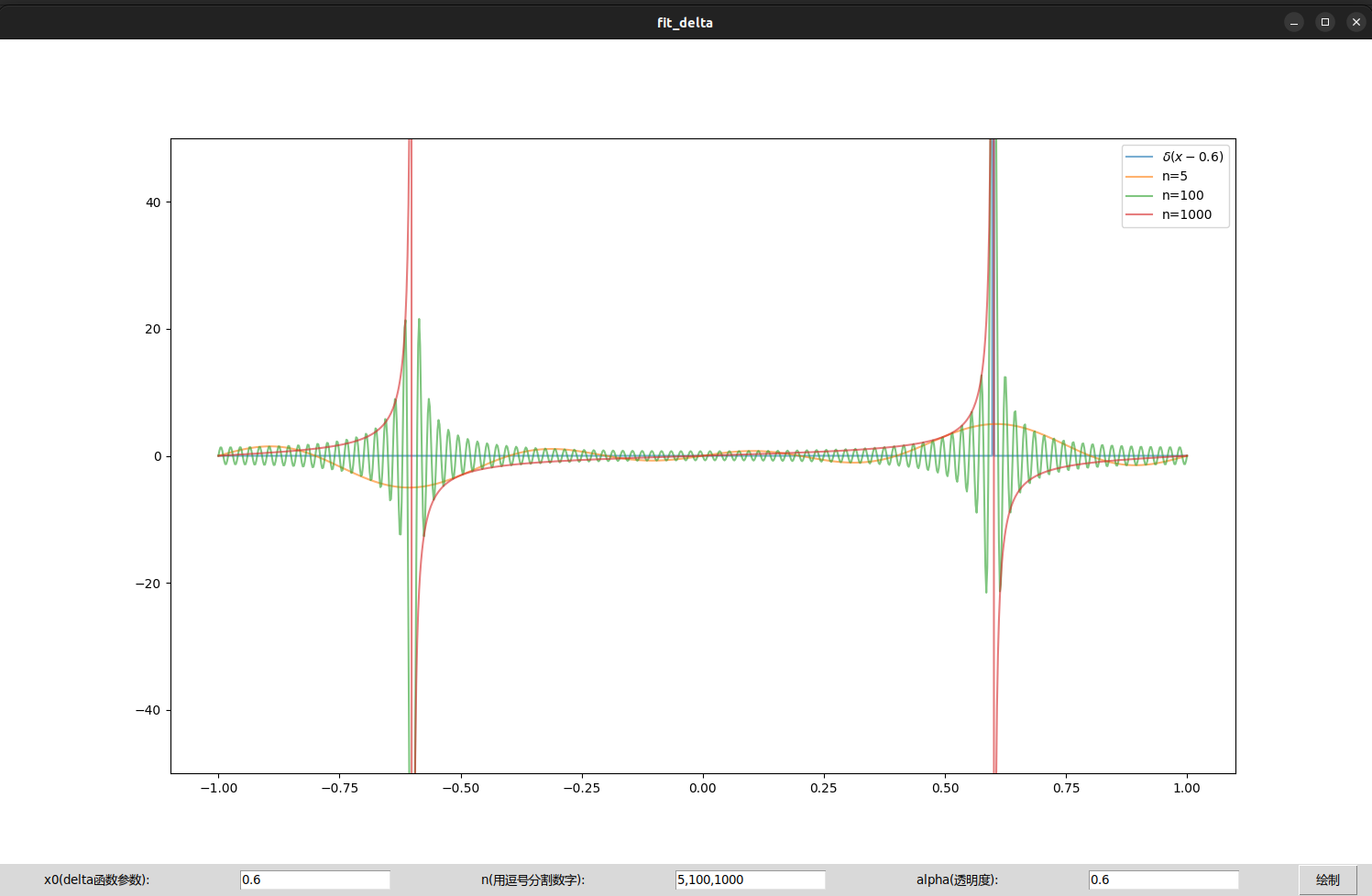数理方法作业15第一题
用本征函数组展开
用正交完备归一化的本征函数组
使用python绘制动态图
下图演示了级数项数

该动画使用python和manim绘制
绘制代码如下:
py
from manim import *
class Plot(Scene):
def construct(self):
# draw axes
ax = Axes(
x_range=[-1, 1, 0.2],
y_range=[-50, 50, 10],
axis_config={'color': BLUE},
x_axis_config={
'numbers_to_include': np.arange(-1, 1.01, 0.2),
},
y_axis_config={
'numbers_to_include': np.arange(-50, 50.01, 100),
},
tips=False,
)
ax_label = ax.get_axis_labels()
# draw delta(x-x0)
x0 = 0.6
x_vals = [-1, x0, x0, x0, 1]
y_vals = [0, 0, 1000, 0, 0]
delta_curve = ax.plot_line_graph(x_vals, y_vals, vertex_dot_radius=0)
delta_label = MathTex('\\delta(x)', color=YELLOW).move_to(RIGHT*4.3+UP*3)
# fit(x)
def fit(x, n):
y = x * 0
for i in range(n):
k = i + 1
y += 2 * np.sin(x0 * k * np.pi) * np.sin(k * np.pi * x)
return y
# draw fit_curve
n = [1, 5, 10, 20, 50, 100, 200, 500, 1000]
def draw_fit(n):
fit_curve_n = ax.plot(lambda x: fit(x, n), color=GREEN)
fit_label_n = ax.get_graph_label(
fit_curve_n, 'n='+str(n), x_val=0.2, direction=UP
)
self.play(Create(fit_curve_n), run_time=1)
self.play(Create(fit_label_n), run_time=0.5)
self.wait(2)
self.play(FadeOut(fit_curve_n), FadeOut(fit_label_n), run_time=0.5)
# the order of animation
self.play(Create(ax))
self.play(Create(ax_label), run_time=0.5)
self.play(Create(delta_curve))
self.play(Create(delta_label), run_time=0.5)
for i in n:
draw_fit(i)
self.wait(1)1
2
3
4
5
6
7
8
9
10
11
12
13
14
15
16
17
18
19
20
21
22
23
24
25
26
27
28
29
30
31
32
33
34
35
36
37
38
39
40
41
42
43
44
45
46
47
48
49
50
51
52
53
54
2
3
4
5
6
7
8
9
10
11
12
13
14
15
16
17
18
19
20
21
22
23
24
25
26
27
28
29
30
31
32
33
34
35
36
37
38
39
40
41
42
43
44
45
46
47
48
49
50
51
52
53
54
用python绘图(GUI交互界面)
利用python程序作图,脚本如下:
运行环境
运行该脚本除了安装python运行环境之外, 还需要安装python的numpy、matplotlib和tkinter模块才能运行。
程序使用
运行程序后图像底部有三个参数可以设置, 其中参数x0是 0.6; 参数n是取本征函数组的前n项并分别绘制,默认为5,100,1000; 参数alpha是绘制函数曲线的透明度,接受的数值大小 0.6 。
修改参数后点击绘制按键即可根据新参数重新绘图。
py
import numpy as np
import matplotlib.pyplot as plt
from matplotlib.backends.backend_tkagg import FigureCanvasTkAgg
import tkinter as Tk
# 相关参数
x0 = 0.6
l = 1
n = [5, 100, 1000]
alpha = 0.5
# 待拟合的delta函数
def delta(x, x0, l):
err = l / 1000
judge = np.abs(x[:]-x0)<err
return judge * 10000
# 拟合函数
def fit(x, x0, n):
y = x * 0
for i in range(n):
k = i + 1
y += 2 * np.sin(x0 * k * np.pi) * np.sin(k* np.pi * x)
return y
# 绘制图像
def draw(ax, x0, l, ns, alpha):
x = np.linspace(-l, l, 1000)
ax.plot(x, delta(x, x0, l), alpha=alpha, label='$\delta(x-$' + f'{x0:.1f}' + '$)$')
for n in ns:
ax.plot(x, fit(x, x0, n), alpha=alpha, label='n=' + f'{n}')
ax.legend()
ax.set_ylim(-50, 50)
# 接受参数重新绘图
def rplot():
# 接受参数
x0 = float(x0_input.get())
str_n = str(n_input.get()).split(',')
ns = []
for n in str_n:
ns.append(int(n))
alpha = float(alpha_input.get())
# 重置画布并绘图
fig.clf()
ax = fig.add_subplot(111)
draw(ax, x0, l, ns, alpha)
canvas.draw()
# 绘制gui界面
root = Tk.Tk()
root.title('fit_delta')
# 绘制三个参数输入框
Tk.Label(root,text='x0(delta函数参数):').grid(row=1,column=0)
x0_input=Tk.Entry(root)
x0_input.grid(row=1,column=1)
x0_input.insert(0,'0.6')
Tk.Label(root,text='n(用逗号分割数字):').grid(row=1,column=2)
n_input=Tk.Entry(root)
n_input.grid(row=1,column=3)
n_input.insert(0,'5,100,1000')
Tk.Label(root,text='alpha(透明度):').grid(row=1,column=4)
alpha_input=Tk.Entry(root)
alpha_input.grid(row=1,column=5)
alpha_input.insert(0,'0.6')
Tk.Button(root,text='绘制',command=rplot).grid(row=1,column=6,columnspan=7)
# 设置画布
fig = plt.figure(figsize=(15, 9))
canvas = FigureCanvasTkAgg(fig, master=root)
canvas.draw()
rplot()
canvas.get_tk_widget().grid(row=0, columnspan=7)
Tk.mainloop()1
2
3
4
5
6
7
8
9
10
11
12
13
14
15
16
17
18
19
20
21
22
23
24
25
26
27
28
29
30
31
32
33
34
35
36
37
38
39
40
41
42
43
44
45
46
47
48
49
50
51
52
53
54
55
56
57
58
59
60
61
62
63
64
65
66
67
68
69
70
71
72
73
74
2
3
4
5
6
7
8
9
10
11
12
13
14
15
16
17
18
19
20
21
22
23
24
25
26
27
28
29
30
31
32
33
34
35
36
37
38
39
40
41
42
43
44
45
46
47
48
49
50
51
52
53
54
55
56
57
58
59
60
61
62
63
64
65
66
67
68
69
70
71
72
73
74
程序运行结果如下图所示:

结论
随着拟合项数
n的增加,级数但是由于本征函数组